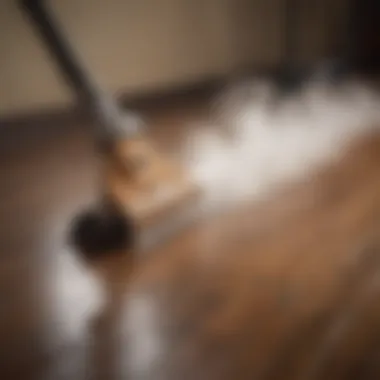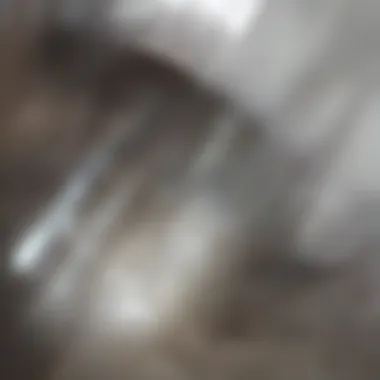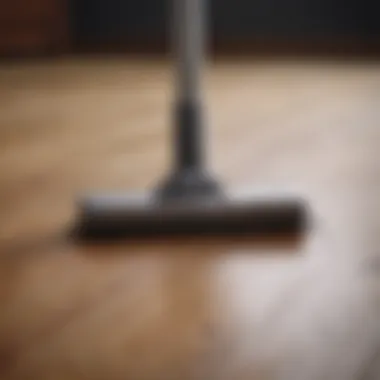Steam Cleaning Techniques for Fake Wood Floors


Intro
Maintaining the appeal of fake wood floors is essential for many homeowners. These surfaces, often made of laminate or vinyl, mimic the look of real wood while offering increased durability and lower maintenance. Steam cleaning has emerged as a popular method for cleaning various floor types, but it is crucial to understand its implications on synthetic surfaces like faux wood.
The use of steam cleaning techniques can enhance the aesthetic qualities of your floors. However, it is not without potential risks. This article provides detailed insights into how to appropriately employ steam cleaning for fake wood floors. It outlines best practices to ensure that these surfaces not only remain visually striking but also retain their structural integrity over time.
By exploring the suitability of steam cleaning for faux wood, this guide will address common misconceptions, helping homeowners and design aficionados make informed decisions. The focus will be on actionable advice, with emphasis on both risks and rewards associated with steam cleaning synthetic flooring.
Understanding Fake Wood Floors
In this section, we will explore the significant aspects of fake wood floors. Understanding the characteristics of these surfaces is crucial for several reasons. First, it enables homeowners to make informed cleaning decisions, especially when considering methods like steam cleaning. Second, knowing the various types of fake wood allows for better maintenance strategies that can prolong the life of the flooring.
Definition and Composition
Fake wood floors, often referred to as synthetic or engineered flooring, are designed to mimic the appearance of natural wood while providing certain advantages. The composition of these floors usually involves a core layer made from high-density fiberboard or vinyl material, topped with a photographic layer that displays a realistic wood grain pattern. This structure allows for a durable and often cost-effective alternative to traditional hardwood floors.
Types of Fake Wood Floors
There are several types of fake wood floors, each contributing unique characteristics and advantages. Understanding these types can guide cleaning techniques and maintenance.
Laminate
Laminate flooring is composed of several layers fused together through a process of lamination. The top layer is usually a wear layer that adds protection against scratches and dents, making it a popular choice for high-traffic areas. Its key characteristic is the ability to resist moisture to some extent, which is beneficial for many household environments. However, one should note that excessive moisture can lead to warping, thus necessitating careful cleaning methods.
Vinyl Plank
Vinyl plank flooring is known for its water resistance and ease of installation. Made from polyvinyl chloride (PVC), it consists of multiple layers, including a backing, a core, and a surface layer. This type of flooring is particularly popular because it comes in a variety of designs, mimicking various wood types. Its unique feature lies in its softness underfoot, resulting in comfort. One disadvantage may be its susceptibility to scratches, which means that proper cleaning practices are essential.
Engineered Wood
Engineered wood flooring comprises layers of real wood veneer adhered to a plywood or composite core. This structure allows it to expand and contract with changes in humidity better than traditional hardwood. The key aspect of engineered wood is its authentic wood look, providing aesthetic value. It can be sanded down and refinished multiple times. However, it is important to handle cleaning and maintenance carefully, as moisture can affect the adhesive holding the layers together, potentially leading to damage.
Steam Cleaning Overview
Understanding the process of steam cleaning is crucial for homeowners considering this method for maintaining their fake wood floors. This section outlines the fundamentals of steam cleaning, highlighting its significance in cleaning techniques tailored to faux flooring.
What is Steam Cleaning?
Steam cleaning is a method that utilizes vaporized water to clean surfaces. This process operates by heating water to a point where it creates steam, which is then directed onto the floor. The high temperature of the steam effectively loosens dirt, grime, and bacteria, making it easier to wipe away. Unlike traditional cleaning methods, steam cleaning does not require the addition of harsh chemicals, emphasizing its strength in cleaning while also being gentle on floors.
Benefits of Steam Cleaning
Deep Cleaning Capability
One of the notable benefits of steam cleaning is its deep cleaning capability. This method penetrates crevices and areas that other cleaning techniques often miss. By utilizing steam, it provides a more thorough clean that effectively removes embedded dirt and stains. Therefore, it is particularly suitable for synthetic surfaces which may crudely mask grime. The unique ability of steam to reach high temperatures helps eliminate allergens, which adds to the appeal of this cleaning option.
Sanitizing Effects
Another key benefit is the sanitizing effects steam cleaning provides. The heat from the steam eliminates 99.9% of common household bacteria and pathogens. This characteristic makes steam cleaning an attractive choice for households wishing to maintain a hygienic living space without relying on chemical disinfectants. As a result, homeowners can confidently clean their floors knowing harmful microorganisms are greatly reduced.
Eco-Friendly Cleaning Method
Steam cleaning stands out as an eco-friendly cleaning method. Since it primarily relies on water, it reduces the use of chemical agents that can harm the environment. This feature aligns with a growing demand for green cleaning practices. Moreover, steam cleaning uses less water compared to traditional mopping, which minimizes water wastage. Consequently, this method appeals to those who are conscious about their ecological footprint.


"Steam cleaning offers a powerful yet gentle approach to maintaining synthetic wood surfaces, emphasizing cleanliness and sustainability."
Overall, steam cleaning proves to be a significant method for maintaining fake wood floors, integrating effectiveness with environmental awareness. As we move forward, it is important to consider the suitability of steam cleaning for different types of synthetic flooring to avoid damaging the surfaces.
Suitability of Steam Cleaning for Fake Wood Floors
Understanding the suitability of steam cleaning techniques for fake wood floors is paramount for homeowners and design enthusiasts. This section delves into the factors that influence the adoption of steam cleaning as a method for maintaining faux wood surfaces. It provides crucial insights into the specific materials used in these floors and highlights recommendations from manufacturers.
Materials Consideration
Water Resistance
Water resistance is a key aspect in evaluating whether steam cleaning is appropriate for fake wood floors. Laminate, vinyl plank, and engineered wood all exhibit varied levels of water resistance. This characteristic is crucial because most synthetic floors must withstand moisture without warping.
The unique feature of water resistance lies in its ability to repel water, preventing it from seeping into joints and seams. This quality makes many synthetic flooring options a beneficial choice for steam cleaning since robust water resistance minimizes the risk of damage from steam.
However, it is essential to note that not all fake wood floors are equally water-resistant. Some inferior quality options may be more susceptible to water damage. Homeowners should confirm their floor type's specific resistance level before opting for this cleaning method.
Heat Sensitivity
Heat sensitivity is another critical consideration when evaluating the suitability of steam cleaning for fake wood floors. Different materials react differently to heat, which steam cleaning applies. For instance, while vinyl plank flooring can tolerate some level of heat, laminate may warp or buckle if exposed to excessive heat.
The notable characteristic of heat sensitivity is that it defines how materials respond to high temperatures. This is significant because engineered wood flooring, for instance, combines natural wood with adhesives that can become unstable when exposed to steam heat over time.
While steam cleaning can effectively remove residue and bacteria, it carries the risk of damage if applied improperly. Homeowners should always consider the heat tolerance of their specific flooring type to ensure that steam cleaning does not compromise the floor's structural integrity.
Manufacturer Recommendations
Manufacturer recommendations serve as a guiding tool for homeowners when determining the best cleaning method for their fake wood floors. Many manufacturers advise against using steam cleaning on synthetic surfaces due to the potential risks like deformation and damage to the finish. Each flooring type comes with its own set of instructions tailored to its materials. It is essential to adhere to these guidelines to maintain warranty coverage and ensure longevity.
In summary, the suitability of steam cleaning for fake wood floors hinges on understanding the materials involved and following manufacturer guidelines. Being well-informed about the resistances and sensitivities will prevent costly mistakes and keep your floors looking their best.
Risks of Steam Cleaning Fake Wood Floors
Steam cleaning can be an effective way to maintain the appearance of fake wood floors, but it comes with potential risks. Understanding these risks is crucial for homeowners looking to utilize this method. By being aware of possible damages, the integrity of your faux wood flooring can be protected, ensuring it retains its aesthetic appeal over time.
Potential Damage
Warping
Warping refers to the bending or distortion of the flooring material due to exposure to heat and moisture. This can happen when steam penetrates the layers of fake wood flooring. The key characteristic of warping is that it can alter the flat, polished surface into an uneven one, affecting not just the look but also the functionality of the floor.
The unique feature of warping is that it results from improper steam cleaning techniques or overexposure to heat. The advantage of knowing about warping is that homeowners can take preventive measures, such as using lower heat settings or limiting the use of steam cleaners. Without a clear understanding of this damage, one could mistakenly believe that steam cleaning is always safe for all types of flooring.
Squeaking Sounds
Squeaking sounds can occur due to loose floorboards or inadequate adhesion between layers of the flooring. When steam is applied, it can cause the material to slightly rise, leading to an audible noise when walking on the surface. The primary characteristic of squeaking is that it can indicate underlying issues that may require more than just surface remedies.
Understanding squeaking allows homeowners to act. It highlights the need for regular inspections after steam cleaning sessions. While the sound itself might seem minor, it could reflect more significant problems beneath the surface. If addressed early, potential costly repairs can be avoided.
Delamination
Delamination is the separation of layers within a flooring product. It is particularly relevant for laminated floors, where the top layer can peel away from the core. Delamination often arises when excessive moisture accumulates without proper drying. Its key characteristic is that it leads to irreversible damage if not caught in time.
The understanding of delamination is critical. Recognizing this issue early means homeowners can switch to safer cleaning methods before significant damage occurs. While it may seem that steam cleaning can offer deep cleaning advantages, the risk of delamination may overshadow potential benefits, prompting a reassessment of cleaning techniques.


Effect on Finish
Fading
Fading is the reduction in the vibrancy of the floor's color due to exposure to steam and heat. This can lead to uneven tones across the surface of the flooring. Fading is a gradual process, often unnoticed until significant discoloration appears. The primary concern here is aesthetics; a faded floor can diminish the beauty of an interior space.
Being aware of fading helps inform homeowners about the limitations of steam cleaning. It urges the selection of methods that preserve color, such as gentle mopping with specified cleaning solutions for fake wood flooring.
Peeling
Peeling is the action where the surface layer of the flooring separates from the underlying material. It can happen when exposed to heat and moisture, compromising the floor's integrity. The key characteristic of peeling is that it often entails a complete loss of the flooring’s aesthetic as well as functional properties.
Understanding peeling is vital in maintaining the longevity of your flooring. It signals the need for immediate intervention. Without this knowledge, one might continue steam cleaning, inadvertently accelerating the degradation of their floors.
End
Awareness of these risks empowers homeowners. By recognizing potential damages like warping, squeaking sounds, and delamination, as well as effects on finishes such as fading and peeling, careful consideration can be applied to their cleaning methods. This enhances not just the look of the floors but also their longevity.
Best Practices for Steam Cleaning Fake Wood Floors
To ensure effective, safe cleaning of fake wood floors, following best practices is essential. This not only preserves the aesthetics of your flooring but also extends its lifespan. In this section, we will focus on key elements, considerations, and benefits that underlie effective steam cleaning practices.
Preparation Steps
Clearing the Area
Clearing the area is the first step in the cleaning process. It involves removing all furniture and items from the floor. This contributes significantly to achieving a thorough clean. By creating a clear space, you allow easy access to all floor areas, ensuring no spot is missed during the steam cleaning process. A clean, unobstructed area helps prevent accidents, such as tripping over items or damaging furniture.
The key characteristic of this step is organization. It is crucial to systematically remove items so that you do not overlook any areas. This step is beneficial in creating a focused environment for cleaning. A unique advantage is that it provides you with an opportunity to assess the condition of the floor.
Vacuuming Loose Dirt
Vacuuming loose dirt serves as an important preparatory step before steam cleaning. It helps eliminate surface dirt and debris, which can interfere with the steam cleaning process. By vacuuming first, you also reduce the amount of dirt that might be lifted and spread around during steaming.
The key aspect here is efficiency. This step is popular because it enhances the overall impact of steam cleaning. Vacuuming ensures that unwanted particles do not turn into mud when exposed to steam. A unique feature of this practice is that it allows for deeper penetration of steam into the floor surface. Therefore, vacuuming dirt effectively minimizes the risk of uneven cleaning results.
Using the Right Equipment
Choosing a Reliable Steam Cleaner
Selecting a reliable steam cleaner is paramount. It ensures that you have the best tools for your cleaning tasks. A high-quality steam cleaner can effectively apply steam without damaging the faux wood surface. In addition, a reliable cleaner provides consistent steam pressure and heat, facilitating effective sanitation and dirt removal.
The key characteristic of a good steam cleaner is its temperature control. This aspect is crucial for adapting to various surface materials. Choosing a reputable brand assures the longevity and efficiency of the machine. Unique advantages include user-friendly designs that simplify operation, making it accessible for most users.
Selecting Attachments for Flooring
Selecting appropriate attachments is important for cleaning different floor types. Many steam cleaners come with specialized tools for various surfaces, including faux wood. These attachments enhance the efficacy of the cleaning process by allowing more targeted cleaning.
The key characteristic here is versatility. Having the right attachments helps tackle specific cleaning challenges effectively. This practice is beneficial because it maximizes the cleaning power of the steam cleaner while protecting the floor's finish. Unique features may include brushes designed specifically for faux wood surfaces, which can provide a deeper clean without causing scratches or damage.
Application Techniques
Optimal Temperature Settings
Using optimal temperature settings is critical for effective steam cleaning. The right temperature can maximize dirt removal while minimizing potential damage to the floor.


The key aspect of temperature settings is managing heat to ensure safety. This consideration is essential for any type of faux wood floor. Choosing the right temperature ensures the floor surface is neither too hot nor too cold, maintaining its integrity. A unique feature is the ability to adjust settings for specific areas or stains, providing an effective cleaning solution that does not compromise the floor’s materials.
Movement Patterns for Effective Cleaning
Following specific movement patterns during steam cleaning contributes to cleaning effectiveness. Consistent and systematic movements help ensure thorough coverage of the entire floor surface.
The critical characteristic of this technique is efficiency. Correct patterns allow for a balanced application of steam, minimizing the risk of moisture build-up. This practice is increasingly popular because it promotes a uniform cleaning process. A unique disadvantage, however, is that inconsistent movements may lead to streaks, requiring additional cleaning efforts post-steam application.
Following these best practices is essential to maintain the beauty and integrity of your fake wood floors, ensuring they remain inviting and visually appealing.
Alternative Cleaning Methods
In the discussion of maintaining fake wood floors, considering alternative cleaning methods is crucial. While steam cleaning has garnered attention, it is not always the best fit for every flooring type. Understanding various cleaning approaches can help homeowners choose the most suitable technique for sustaining their unique floor's quality and appearance.
Mopping Techniques
Using Microfiber Mops
Microfiber mops have become a popular choice for cleaning fake wood floors. They are specifically designed to trap dirt and dust effectively without scratching the surface. The key characteristic of microfiber is its ability to hold onto debris, making cleaning more efficient. For fake wood floors, this avoids any abrasive damage that traditional mops might cause. This makes microfiber mops an ideal choice for daily or routine maintenance, helping to maintain the floor's aesthetic appeal and longevity.
One unique feature of microfiber mops is their washable nature. Unlike disposable options, these mops can be used multiple times, offering a cost-effective and eco-friendly cleaning solution. However, it is essential to wash them properly to maintain their effectiveness. The main disadvantage is that, if not maintained well, they can harbor bacteria, which could prevent effective cleaning.
Appropriate Cleaning Solutions
The choice of cleaning solution is just as vital as the tools used. An appropriate cleaning solution should be formulated to treat fake wood flooring gently without causing damage. The key characteristic of such solutions is that they are pH-balanced and specifically designed for synthetic materials. Many commercial options do not contain harsh chemicals, reducing the risk of affecting the floor's finish.
One unique feature of the right cleaning solutions is their ability to eliminate stains and marks without leaving residues behind. Over time, inappropriate cleaners can lead to dulled surfaces and possible delamination. Therefore, opting for cleaning solutions meant for fake wood floors provides significant advantages, such as enhanced shine and protection from wear. However, some products may not work effectively on all types of surfaces, so it is essential to read labels carefully before use.
Dry Dusting and Vacuuming
Dry dusting and vacuuming are also viable alternatives to steam cleaning. These methods offer a straightforward approach to keeping floors clean without the risks associated with moisture. Dusting removes loose dirt and allergens effectively. Using a vacuum cleaner equipped with a soft brush attachment will prevent scratches while ensuring thorough cleaning. Consider these alternatives as part of a regular cleaning routine for the best results.
Final Considerations
Understanding the final considerations surrounding steam cleaning fake wood floors is essential for homeowners and design enthusiasts alike. This section emphasizes the long-term implications of cleaning practices on the preservation and aesthetics of faux wood surfaces. The key here is to assess factors that can influence the durability of the flooring materials over time.
Assessing Floor Condition
Before applying any cleaning technique, it is critical to assess the condition of your fake wood floors. Look for signs of wear and tear, including scratches, stains, or discoloration. These indicators can signal whether your floors are ready for steam cleaning or if another approach may be more suitable. Assessing the condition helps prevent further damage. If the floor has significant scratches or a compromised finish, steam cleaning may exacerbate the issues. Conduct a thorough visual inspection and consider a gentle cleaning method if any significant damage is present.
Regular Maintenance Practices
Maintaining your fake wood floors through regular practices can significantly enhance their durability and appearance. The aspects of regular maintenance play a crucial role in reducing the frequency and intensity of deeper cleaning methods, such as steam cleaning.
Scheduled Cleaning
Scheduled cleaning refers to the practice of setting aside specific times for cleaning your floors in a systematic manner. This approach is beneficial as it helps establish a consistent maintenance routine. Implementing a cleaning schedule allows you to keep dirt and grime at bay, preventing build-up that can lead to the need for intensive cleaning methods. One characteristic of scheduled cleaning is the opportunity to target specific areas that may require more attention based on usage patterns and traffic. Its unique feature is the predictability it offers in your cleaning routine, which can lead to a cleaner, healthier home environment. However, it requires discipline and commitment to adhere to the proposed schedule, which may be seen as a disadvantage for some homeowners.
Preventive Measures
Preventive measures are essential practices that aim to protect your faux wood floors from damage and wear. This includes using area rugs in high-traffic zones, keeping pets' nails trimmed, and avoiding the use of harsh chemicals on the flooring. Preventive measures can help maintain the integrity of the surface finish. A significant characteristic of this approach is its proactive nature; rather than waiting for damage to occur, it actively seeks to minimize it. This reduces the need for future cleaning efforts to address issues caused by negligence. The unique feature of preventive measures is that they can significantly extend the lifespan of your floors. While the initial effort may seem demanding, the long-term benefits often outweigh the disadvantages, as preserving your investment in flooring is ultimately beneficial.
The End
In this comprehensive exploration of steam cleaning for fake wood floors, we have examined numerous elements surrounding this method and its suitability. Understanding the unique properties of faux wood surfaces is essential when considering steam cleaning as a viable maintenance option. The key insights derived from this discussion underscore the importance of knowing your flooring type, its resistance to heat and moisture, and the specific manufacturer recommendations.
The benefits of steam cleaning, including the ability to deeply sanitize surfaces and eliminate dirt in hard-to-reach places, cannot be overstated. Yet, the risks, such as warping or damage to the finish, present significant considerations for homeowners and design enthusiasts alike. Thus, an informed approach is paramount. Regular assessment of floor condition and adherence to best practices contribute tremendously to the preservation of the aesthetic appeal of these surfaces.
For those choosing to steam clean, acknowledging the nuances of this technique, like appropriate temperature settings and movement patterns, enhances effectiveness while minimizing potential damage. Alternatively, exploring other cleaning methods can also provide homeowners with options that may better suit their specific floor type or personal preferences.
Ultimately, the overarching takeaway from this guide highlights the necessity of balancing effective cleaning with considerations of floor integrity, thereby ensuring that faux wood surfaces maintain their beauty and longevity over time.







